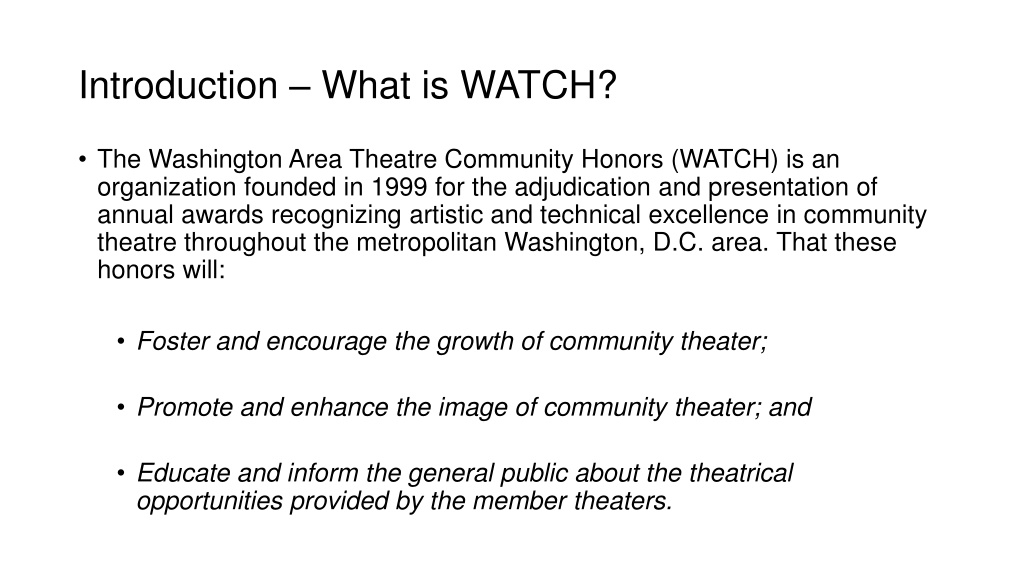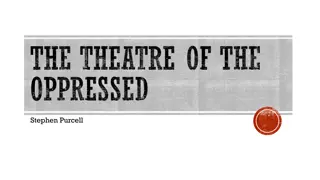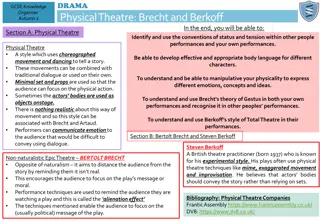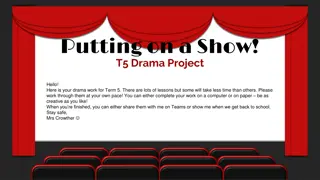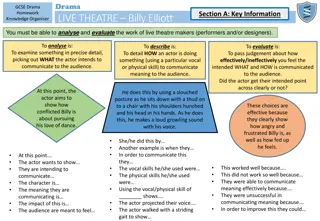Understanding WATCH: The Washington Area Theatre Community Honors
WATCH (The Washington Area Theatre Community Honors) is an organization established in 1999 to acknowledge excellence in community theater in the metropolitan Washington, D.C., area. They conduct annual adjudication and awards ceremonies to foster the growth of community theater, enhance its image, and educate the public about local theatrical opportunities. Volunteer-based companies participate in adjudication, and judges are selected to evaluate productions throughout the year, culminating in an awards ceremony in March.
Download Presentation

Please find below an Image/Link to download the presentation.
The content on the website is provided AS IS for your information and personal use only. It may not be sold, licensed, or shared on other websites without obtaining consent from the author. Download presentation by click this link. If you encounter any issues during the download, it is possible that the publisher has removed the file from their server.
E N D
Presentation Transcript
Introduction What is WATCH? The Washington Area Theatre Community Honors (WATCH) is an organization founded in 1999 for the adjudication and presentation of annual awards recognizing artistic and technical excellence in community theatre throughout the metropolitan Washington, D.C. area. That these honors will: Foster and encourage the growth of community theater; Promote and enhance the image of community theater; and Educate and inform the general public about the theatrical opportunities provided by the member theaters.
Introduction Who and Where is WATCH? WATCH is a group of volunteer-based community theatre companies operating in the metropolitan Washington D.C. area. The WATCH Board of Directors is comprised of one representative from each member company. www.washingtontheater.org - Note that theater is spelled with er.
Introduction Awards and Judges Adjudication for the WATCH Awards follows the calendar year: January 1 through December 31 A ceremony is held in March to present awards from the previous adjudication year. Each year the member companies submit their productions for adjudication. Member companies also provide 4 judges and sometimes one or more alternate judges. Each primary judge will be asked to adjudicate approximately 10 productions throughout the year. It may be more or less depending on cancelled shows, or requests for backup by judges unable to attend. If you are a primary judge you are committing yourself for the entire year and you are willing to travel to any of the member theaters from Warrenton, VA in the west, to Annapolis, MD in the East, Columbia, MD in the north down to La Plata, MD in the south.
Introduction Awards and Judges (contd) A list of judging assignments for the entire year will be published by January 1st. This list is commonly referred to as the judging matrix or simply The Matrix . Because this list is generated at the beginning of the year, The Matrix will have space holders listed as TBD in order to accommodate shows that have not yet been selected or announced. The assignments are chosen at random so you can expect to see shows throughout the wide metropolitan area and throughout the year. Each production is adjudicated by 10 judges from different member companies. You will never be assigned to a show produced by your home company.
Why you were selected For your experience in theater On stage and backstage in community theater. We hope you have a background in many areas of theatrical production. As an audience member of community theater. For your support of all community theater Regardless of what company you represent, we expect you to be fair and unbiased when judging. For your sense of responsibility We are counting on you to fulfill the commitment you are making to view and fairly judge the shows assigned to you.
What is expected of you as a judge Make a reservation, attend, and view each of your assigned shows. Properly complete and submit a ballot for each assignment. If you are unable to fulfill one of your assignments, please inform your WATCH representative as early as possible so an alternate judge can be selected. Please request an alternate in the following situations: Your schedule prevents you from attending any of the scheduled performances. You are in or working on the show. You have (or others might feel you have) a conflict of interest (because your spouse is the director, lead actor, etc). You serve on the board of the producing theater. You feel, for any reason, that you cannot make an unbiased adjudication of a show (or element of a show).
At the theater Do not leave the performance before the production is over, it is considered extremely poor etiquette and we do hear about it. Look in the Playbill. Are there photos of the actors? If not, you may want to take a cellphone picture of the lobby display of headshots; it s very helpful later when you can t put a face to a character name. You are not restricted from talking to members of the production about your likes and dislikes, so long as that conversation does not mention scores or influence the scores you would give. For example, if you did not understand the director s vision while watching the show, but it became clear afterward when it was explained, you must score it as if it had not been explained to you.
Communication All of the judges, alternate judges, and representatives will be added to an email distribution list. This is only used for communicating WATCH adjudication information. You will receive a Weekly Report by email from the Adjudication Coordinator listing all of the relevant assignment information. Please review this report each week, as it has the most up to date information available. The weekly report contains a lot of information; an easy way to skim the report is to search for your name or your company s acronym. When you make a reservation to attend a show, email your reservation date to the Adjudication Coordinator. This is the best way to ensure that all of the judges are receiving the weekly report and keeps everyone up to date on adjudication status. If you are unable to attend an assignment after making a reservation, please cancel your reservation with the producing company. If you are unable to attend in an emergency situation when a show is about to close, please contact both your representative and the Adjudication Coordinator so that an emergency alternate can be identified.
Tickets and Reservations At the beginning of each year the judges will receive a Just the Facts document which contains information specific to each individual theater, address, directions, ticketing information, etc. Each company s ticketing process is different. The Weekly Report and Just the Facts documents spell them out. You must make a reservation for every assignment. Never assume that a theater can accommodate you without a reservation. Your ticket as a judge is free for all assigned productions. Many, but not all, companies also offer a free companion ticket. Companion ticket policies are specific to each company and can be found in Just the Facts. Please plan ahead. Don t wait until the last minute to make a reservation for the only performance you are available to attend.
Tickets and Reservations (contd) Do not make reservations for closing night. Closing nights should be reserved for emergency alternates only. It is not uncommon for performances to be canceled due to emergency or weather situations. Be aware of performance times. Plan to arrive at the theater 15-30 minutes early. Be careful of half-hour curtains (7:30pm, for example). Take traffic into consideration when planning your trip. Double check the venue address and directions. Some theatres have separate performance and business addresses. Bring the information with you. Make sure you allow extra time to find a theater that is new to you.
Participation and Interaction Judges are neither discouraged nor encouraged to participate in shows that interact with the audience. Your wish to participate or not is entirely up to you. Your role as a judge should not be used as an excuse not to participate. If you do not wish to participate, politely decline without mentioning your judge status.
Balloting Basic Guidelines The e-ballot can be found on the WATCH website, and included as a link in the Weekly Report. Only use the information in the playbill to complete your ballot. Any additional information provided to you by the producing company should be considered not official . Fill out the ballot completely scoring every identifiable element. Submit your ballot within 10 days after viewing your assignment. No ballots will be accepted after 30 days of a show closing. Make sure your email address is entered correctly and that you choose your correct company and the correct producing company.
Balloting Basic Guidelines (contd) Save or print a copy of your ballot in case there is a submission problem. After you submit a ballot, you will receive a confirmation email from the Tabulator. This email is generated manually after your ballot has been received and recorded. A confirmation email is generally received within 24 hours, but on rare occasions could take up to a week. Your ballot is highly confidential. Your individual scores will not be divulged to anyone. Your WATCH representative may be provided with comparisons of your scores against the averages for individual shows. This information is provided only to help judges adjust their average, when necessary. Please do not talk about your scores with anyone.
Balloting - Performances Always go with the playbill! List the cast in the same way and in the same order as the playbill. If there is a character name please list it on the ballot even if they were not identifiable on stage. Do not list groups or choruses. If the character is plural (for example, nuns, waiters) do not list them. Do not list animals. If an actor is playing more than one character and all of the characters are listed together in the playbill, then list it that way on the ballot with one score. If an actor is playing multiple characters and each of those characters are listed separately in the playbill, then list the characters the same way on the ballot and score each one.
Balloting A Lead Role is: If a character is performed by more than one actor (where there is an understudy for example) score the performance you saw. The ballots will be tabulated as if one person performed that character and arrangements will be made during tabulation should the performance get a nomination. Who the story is about or whose presence is primary to the piece. There may be multiple leads or none at all. Provide a score for every existing element whether it is listed in the playbill or not. Just because someone was omitted from the playbill, does not mean we should overlook scoring their work. A Featured Role is: A supporting character that cannot be designated as a lead or a cameo. If a production does not have an element, choose N/A for Not Applicable. For instance, plays do not usually have Musical Direction or Choreography. Also, many productions will not have Stage Combat or Special Effects. A Cameo Role is: Judges have the option of including constructive comments with their ballot, up to a maximum of 500 characters. Comments should be include information that might be useful to the company to improve future performances, such as trouble hearing the actors, sightline issues, etc. Comments should not be used to explain why you scored a particular way, or to comment on why you liked or disliked something in particular. A memorable performance by an actor with limited stage time. In a musical, the incidental character appearing in one scene with a memorable song or production number; in a comedy, the incidental character who appears in, and steals, a single scene; in a drama, the incidental character who delivers a single pivotal monologue. Additional Considerations: If a character is listed in the playbill and you can t identify them on stage, select N/I for not identifiable .
Scoring 10 Excellent/Highest Possible 9.5 9 Outstanding/Remarkably High 8.5 8 Superior/Remarkably Above Average 7.5 7 Noticeably above average 6.5 6 Slightly above average 5.5 5 Average 4.5 4 Fair 3.5 3 Noticeably below average 2.5 2 Poor 1.5 1 Did not meet criteria N/I Not identifiable
Scoring Considerations Each element and performance is given a score between 1 and 10. 10 is the highest. It is okay to give lots of 5s. A 5 means that it was good. Don t be afraid to over-use your 5s. Scores should be based on the adjudication criteria provided by WATCH including consideration for level of difficulty. A 6 means that it positively caught your attention. A 7 and up, means that it was special or that the level of difficulty made it deserving of elevation. Rely on your experience. Choose scores in the context of what is average in WATCH Community Theatre to you. If it wasn t good score it below a 5. Remember, no one is going to see your scores. Your 7s and above should be for special performances and technical achievements. Remain consistent to your average throughout the season. Do not adjust your scoring, because you feel you were too easy or too hard at the beginning of the year. If you are giving a 7 or higher, you are saying that the performance or element is worthy of a nomination. Evaluate each performance and element separately. Do not fall into the trap of scoring every category high or low based on the overall production. If you are giving an 8 or 9, you are saying you believe it to be award-worthy. If you are giving a 10, you are saying this was the most incredible artistic performance or element you have ever seen/heard for an incredibly difficult piece, and clearly deserving of an award. Do not try to rank the ten shows you saw. Score every element of each production based on its own merits. Just because you enjoyed the whole evening of theater, doesn t mean every element deserved a 10.
The Fundamentals The 3 fundamentals for judging a WATCH category: 1) Serve the story being told. 2) Be appropriate to the piece and the presenting space. 3) Be of consistent quality throughout the piece.
Acting/Performance Creative: For Musicals: Character serves the story choices are clear, appropriate, and consistent. Vocal/dance abilities are consistent and appropriate for the character. Gives an honest portrayal of the character Are they believable? Do you see an actor or the character on stage? Do they remain in character during songs and dances as well in an effort to further the story with these media? Technical: Level of Difficulty: Maintains focus throughout. Number of lines, range of songs, amount of dance, number of costume changes, large character arc, physicality of role, transformation to accomplish role, multiple roles, have they brought something to role that was unexpected? Projection, diction, dialect are appropriate and consistent. Movement, physicality appropriate and consistent for development of character. If playing someone outside of their age range, have they altered their physicality, and is it effective? Are they listening and responding or simply waiting their turn? Does it feel like a live performance or are they simply going through the motions?
Set Design A good set design serves both the play and the space where the play is being performed. It accommodates a smooth flow between and within scenes, providing entrances and exits that are logical and identifiable. The set design should reflect the director s vision for the piece, be it realistic or abstract. A good set design affords a visually interesting and aesthetically pleasing composition that balances well with the other technical elements (lights, set dressing, costumes). A good set design should accommodate fluid, rapid scene changes with individual scenes that are well-defined and easily understood; adequate floor space should be provided for blocking and/or choreography. Sight lines should be considered in the set design, which should include appropriate masking for the wings. Look for creative solutions to the unique attributes of the play and/or the space where it is being performed. When a door is opened, the audience should see something appropriate on the other side, such as an exterior, a hallway or an adjacent room rather than a black masking flat or curtain. Take into account whether the performance space is a real theater or an auditorium, gym, converted storefront, etc. Level of Difficulty: A good set design is appropriate to the period and location of the play, and should help to define and support its mood; a good set design defines a world in which the play makes sense Consider the magnitude of the artistic challenge; accomplishing lots of scene changes in a small performance space doesn t necessarily mean the set design was artistically challenging; the challenge might have been in set construction rather than set design. The most artistic set designs are not necessarily the most detailed replicas of life; sometimes the most artistically challenging and aesthetically pleasing set designs are elegantly simple.
Set Construction The set construction should serve the set design, ensure the safety of the performers and facilitate simple, fast, quiet scene changes. Level of difficulty: A great set design does not necessarily mean that the construction of the set was difficult. A perfectly dressed single-room set with a couple of doors can often be built with relative ease using a few stock flats and doors, while a simple-looking, abstract set can involve more challenging set construction if everything must be built from scratch. Good set construction makes creative use of materials in creating the illusion of reality. For example, making a massive-looking crown molding or a stone wall out of Styrofoam. Any set that includes multiple levels and/or a stairway is more difficult to build, and a set with a fully visible second story is particularly challenging. Any set that rotates, rolls, folds, flies, includes a trap door, etc., is even more challenging to build, and you should adjust your score accordingly for a relatively high level of difficulty Good workmanship in set construction can be easy to miss when everything works properly, but even the most simplistic of sets can have bad workmanship which detracts from the overall illusion of reality. Give credit to set construction that pays appropriate attention to detail. For instance, if the set includes a real window, give credit to set construction; if it includes a window that is painted on a wall, give the credit to set painting. In a set of a room in modern times, attention to detail includes things like light switches and outlets on the walls, heating registers, windows and doors that have proper hardware, etc.
Set Painting Serves the set design and the story. Aids in setting place and time. You won t know if the paint scheme/design came from the set designer or the set painter or the director. Ultimately, you have to give credit to the set painter, but it should tie in to the director s vision. Some things to look for: Wall Treatment (sponging, texturing, stenciling, distressing). Is that real wallpaper or stenciling to make it look like wallpaper? Wood graining Stone and Masonry. Was that brick/stone wall painted or is it a plastic sheet or contact paper? Balance with other technical elements. Look for coordination with the other designs of the show. If everything is pastel and ethereal, the paint should not be bright, primary colors. Did the floor get a special paint treatment? Was it spattered to look like concrete, painted to look like planks? Stained Glass Textures and colors appropriate. Backdrops Look past the wow factor. Wow, look at those pops of color! But, are they just blocks of color easy to roll onto a wall? Or is it a true, artistic wow ? Quality Look for an overall product that shows attention to the task. Is the painting sloppy, lines uneven, is paint bleeding through from a previous show, are elements left unfinished, seams not taped? Realism counts, but so does creativity. Also take into account level of difficulty: including large drops, intricate design, painted floor, number of sets versus just one static set, etc.
Set Decoration/Dressing Elements of Set Decoration Elements of Difficulty Enhance and complement the story and set design. Attention to detail, accuracy, artistry, aesthetic display. Define environment and character detail. Number of items and difficulty in acquisition. Create atmosphere, appropriate and authentic to time, place, mood, season and circumstances. One-of-a-kind pieces created for this production, pieces designed to appear or behave differently than real object would or to transform to reveal another use Consistent stage appearance in harmony with show palette (costumes, lighting, set) with appropriate size and color, quality of items. Striking stage appearance, with concept fully realized in all areas decorated, layered on set to create illusion of three-dimensionality and visual interest uplifting the look of the production.
Properties Elements of Properties Elements of Difficulty Enhance and compliment the story, create insight to the character of the owner. Attention to detail, accuracy, authenticity and artistry. Number of items and difficulty in acquisition. Appropriate and authentic to time, place, mood, season and circumstances. Special props - one-of-a-kind, tailor made for this production, designed to behave or appear differently than real object would, fake food, breakaways. Appropriate, natural ease of use and placement on stage. Consumables - eaten, repaired, destroyed or replaced each show. Consistent stage appearance, accuracy and realism with appropriate size, color, behavior or movement. Special effects (in lieu of FX Designer)
Light Design What does Lighting Design include? Technical Considerations General lighting Degree of difficulty How many instruments does the theater have? Type of stage For example a stage in the round is harder to light evenly Specials (localized lighting for specific moments or other reasons) Lights built into the set Effective illumination of stage, actors (as appropriate). Shadows intentional. Practical lights (lamps on the set that actually work) Star drops and so forth Gobos (single color or colored patterns) are lighting, but full-up projections are special effects! Artistic Considerations Does it enhance the story creating time, place, mood? Purposes of Stage Lighting Is it creative in defining space and aiding the flow of the piece? Enable the action to be seen Does it work in conjunction with the set and costumes? Define space Enhance the mood Does the lighting draw attention to itself? And if so, does it make sense in the context of the story? Hide action that should not be seen Make the image on stage look pretty
Sound Design Basics and Baselines Was there practical sound, like door knockers/bells, kitchen activity? Were microphone sound cues seamless and indiscernible switching from dialogue level to singing level? Were there interesting live effects applied to voices or instruments that stood out? Clarity. Whether a musical or play, hearing the story is a must. Microphones balanced between music and voices, and actors between each other. Speakers positioned well and balanced SFX & Music: Going beyond the script to add ambience and realism, like office sounds, nature, kitchen business offstage Underscoring for plays, BIG PLUS Music that connects with the story and characters, not just any piece from the era. Sound effects and music should be appropriate to the script and represented era and work within the venue. Enhancement. Special Effects (SFX) and Music selections should reflect the story and characters and enhance the experience. They should not distract or call attention to themselves (unless that is the intention). Above and Beyond Challenges Technology: Body Microphone placement: discreetly tucked under wigs, hairlines, or costumes or distractingly placed on the actors cheeks with tape? Speaker placement: other than affixed house speakers, were vocal/band/backstage monitors added? Did speaker placement allow sound to emanate from proper directions? Venue: Consider how the sound design was implemented in a challenging space. Churches, rec centers, outdoor, black boxes are more difficult than a traditional theatre. Theatre Resources: All community theatres are not equal. Did the Sound Designer achieve something special/creative within limited means?
Special Effects Artistically Special Effects are any effect that isn t covered by another category. For example, Does it serve the story being told? Or does it take you out of the moment? Fire and pyrotechnics (if they re actual pyrotechnics, not ones simulated with light and sound). This includes things as simple as burning a letter onstage. Is it appropriate to the piece and the space? Does it make sense within the context of the director s vision? The best special effects are the ones you almost don t realize are special effects. Rain or water. Again, only if it s not simulated with light and sound. Smoke and fog, if it s used as an effect (e.g. smoke coming from a stove). General haze to make the stage pretty is lighting. Is the quality consistent throughout the show? Or did they spend all the effort in one place and do a much poorer job at other times? Flying actors or props. Note that a set piece that flies or deliberately falls down is not a special effect. That is set design/construction. Difficulty Magic Was it done safely? Video and projections. This does not include gobos and general lighting texture. That s lighting. Was it surprising or large (while still serving the story) Did it make you wonder how it was done? If you re unsure about a specific effect, ask whether it would have required a special dedicated technician to design/execute.
Costumes Elements of Costume Design Level of Difficulty Costumes relate to dialog or specific references in the script. Trick costumes should work perfectly, with a sense of magic . Costumes are appropriate to time period, season, and location. Fast changes should be fast; Velcro, snaps, zippers in hidden locations for near-instantaneous removal or donning of pieces. Costumes fit with no evidence of discomfort, are in good repair, with no safety pins, tape, glue or Velcro visible. Animals or fantasy characters, or highly imaginative original pieces, or fitting and clothing actors of unusual size or other physical characteristics. Costumes enhance and support the actors roles. Leads are distinctive from others in color and style, and stand out clearly from the ensemble. Unified artistic design; a color palette consistent and appropriate to the mood of each scene; colors harmonize with the set design, and costume colors and styles do not clash. What is a High Level of Achievement? Outstanding design is ingenious, inventive, and unique. There is a flair in the artistic design which contributes significantly to the director s vision for the show. There is no sense that compromises have been made. Other Judging Criteria The costumes reflect the director s overall vision of the play. The costumer should collaborate with other designers. Costumes work well with dance, colors are not adversely affected by the lighting, etc. Attention to detail, including accessories. Alterations are not apparent. No hanging slips, untucked shirts, or anachronistic accessories.
Make-up Design Does the make-up serve the story? Is there a lot of specialty make up (Cyrano de Bergerac s Nose, Shrek s head and ears, Agnes of God s stigmata)? Does it deepen the character? Is the cast large and creatively made up (Seussical, Beauty and the Beast, Shrek)? Is it accurate for the time period? Are there subtle changes in make up to indicate aging or changes in health (Wit (where the effects of stage 4 cancer overtake the actress or The Audience where Queen Elizabeth II goes from her 30s to her 80s). Is it consistent for all the characters in the play? Is it consistent with costumes and lights? Is there a Level of difficulty to the Make-up design?
Hair Design Does the Hair Design serve the story? Is it a large cast production where a lot of specialty wigs are required (for example 1776 or Shrek) ? Does it help project the character? Does the hair style enhance the character especially as they change through time periods in the play (Queen Elizabeth II in The Audience)? Is the style accurate and consistent with the time period being portrayed? Is it consistent with the costumes and make up? If wigs are worn, are they appropriate to the story and are they artfully attached. Is there a level of difficulty to the Hair Design?
Leta Hall Award for Outstanding Ensemble In honor of Leta Hall, who was truly the embodiment of Ensemble. An Outstanding Ensemble award will be given for Play and for Musical. Movement/physicality is appropriate and consistent for development of character by ALL performers. Full cast relates/interacts well with each other. There is consistently high quality from largest to smallest roles, with no weak links. Size of role is not a factor, all performers are weighted equally. The Ensemble score is a composite average of the full company of actors, whether Lead, Featured, Cameo, or otherwise, and how well they worked together as a unit. This category name may cause confusion. We are not referring to the chorus, or background characters (usually referred to as the ensemble). This award is a cast award, for the entire cast as a unit, regardless of the size of individual roles. Additional consideration of musical performances: Vocal/dance abilities consistent and appropriate to ALL the characters. Focus and characters maintained through musical and/or dance numbers by ALL actors. Definition: An ensemble in this case is any cast containing at least four actors (actors who are double-cast/sharing a role will count as one person). You will check a box confirming that you saw at least four actors in the cast. In rare cases, cast members might only interact with a few others, or one other, or even just with the audience, but the ensemble score is still awarded based on how well all support the director's vision. You MUST give a score for this category for ALL productions with four or more performers. NO exceptions. Everyone in the cast is performing the same vision of the show, with one heart. Considerations: ALL characters serve the story and are believable. Choices are clear, appropriate and consistent. Characterizations are sustained throughout (no dropping character, except as might be required by the script). Level of Difficulty: Number of lines, range of songs, amount of dance, lots of costume changes, large range of emotion, physicality of roles, transformations to accomplish roles, multiple roles. Were ALL actors consistently good throughout all these? Projection, diction, dialect (if applicable) are clear and appropriate by ALL perfomers.
Choreography Style Story What is the style of the piece? Style can come from the period the piece is set in, from the concept of the director, or from the book or the material the book is based on/adapted from. What is the story? Did the choreography convey plot and character? Did the choreography fit or change as characters change throughout the story? Did the choreography convey the style, time period, vibe? Space Skills What is the space? Proscenium, in the round, thrust, arena style, etc. The performance space must dictate the choreography. What are the dancing skills of the cast? Note special skills, like gymnastics, or juggling, or roller skating. Is the space large or small? How well do individual dancers blend with each other in synchronized group numbers? Is the production in a theater or in a found space? Was the choreography appropriate to the playing space? Was the choreography appropriately tailored to the skills of the cast?
Combat Choreography Safety: Does it fit the character? Does it look like the actors are going through the motions, or really fighting? Is each punch, kick, cut, or thrust cleanly delivered and reacted to, or does it look like a muddy jumble? Are the characters seemingly fighting for their lives/safety? You should never feel that the actor is at risk of being injured; it is very good if you feel that their character is or may be. Audience should never feel unsafe. Never point a gun, or swing a sword, toward the audience. If the actor loses control of their own (or their partner s) body, it s a sign of unsafe choreography. Level of Difficulty: Intricate movements, variety of styles. Only consider after first three criteria are met. Appropriate: The greater the number of actors fighting together, the greater the difficulty. (8 actors fighting in pairs isn t much more difficult than only 2. 8 actors all fighting with each other is difficult.) Action and weapons serve the story and staging. Fits the tone of the scene and motivation of the characters and does not disrupt the show s momentum/action. The length of the fight, its level of violence and the type of combat serve the staging, story, and director s vision. Too much is as inappropriate as too little. Think of it like over/underacting. Does the fight involve 1-2 simple moves or several intricate ones? Execution: Weapons choice is appropriate to the period/setting Clean and controlled movements. Considerate of singing or acting while fighting. Believable: Considerate of actors' physical abilities. Natural transition into and out of the fight. Think of combat like a dance; if it s too difficult for the capability of the actors, then it s not good choreography. Realistic movements and reactions. Convincing and well acted.
Music Direction What does Music Direction include? Judging the orchestra Teaching the music to the cast Is the orchestra together and working as an overall unit Rehearsing with the orchestra Are the orchestra and cast working together to tell the story Conducting the orchestra Quality of the instrumentalists Is the balance within the orchestra appropriate? What does music direction not include? Judging the level of difficulty Sound balance (Don t penalize MDs for bad sound design) Sound effects How complex is the show musically (how much music, complex harmonies etc.) Whether or not microphones work What is the size of the cast/orchestra Judging the vocals Overall Is the music clean (i.e. are cut-offs together, are entrances sharp, are harmonies correct) Is it clear the music director has worked with the director and choreographer to best present the music in service of the story? Does the music work to tell the story Do dynamics serve the story-telling Are transitions between scenes, songs, and scene changes under music smooth? Can you understand all of the lyrics Are tempos appropriate to the flow and pace of the show Is the balance within vocal sections appropriate? Can you hear the melody? Do the harmonies complement the melody?
Direction Consistent Vision For Musicals Does every element of the show serve the same vision? Seamless song and dance integration as the story is being told? Does the acting style and casting match the story? Do the songs arise from the action, or are they merely independent of the story? Do the design elements (lighting, sound, set, props, costumes, etc.) reinforce this vision? Are dances continuing the vision outlaid by the director, or can you feel the baton being handed off? Is the blocking/staging effective and not distracting? Level of Difficulty: Pacing Certain shows are much more difficult to stage because they require particularly inventive use of the space, or feature uncommon requirements of actors, or have scripts that require more massaging. Does the direction serve the script? Does it move at a speed where everything is effectively communicated, yet not telegraphed? Comedies are just as difficult as dramas to direct. Does the direction serve the script, or the director? You never want to feel that the script is being sacrificed in order to get a laugh or elicit an emotion from the audience. Between the Scenes Are transitions between scenes effective and handled with an eye for necessity?
Overall Production Was the story effectively told? Determine the level of difficulty Become familiar with the story beforehand, if possible Acting challenges Technical aspects Read the director s notes The performance venue Decide if the production fulfilled the director s vision Were technical and performance elements well blended? Beware of The Halo Effect Cohesive vision of all production elements including design, direction, and performance Do not let one or two outstanding elements of the show influence your Overall Production score. Continuity, good flow, and appropriate pacing Overall Production score should not be any higher than the highest score you gave any one component. If acting received high marks, but technical did not, all the elements of the production did not blend together effectively. Overall Production score is not a mathematical equation from your scores of all the categories; it is an assessment that all the elements of the production succeeded in bringing the director s vision to life. For musicals. determine the effectiveness of the integration and execution of music, movement and dance. Determine the impact of the production Were you truly wowed or moved emotionally by the show? If so, was it the performance of one or two actors, or one particular scene, or did you have that feeling from the beginning to the end?
